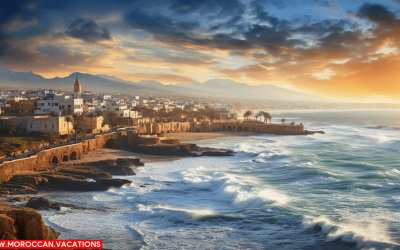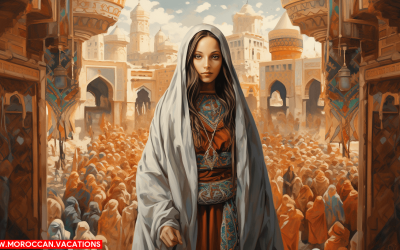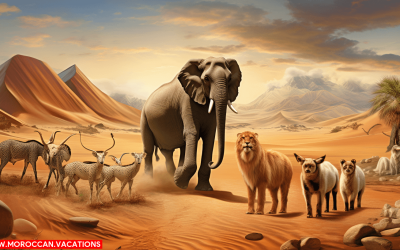Understanding Moroccan Currency
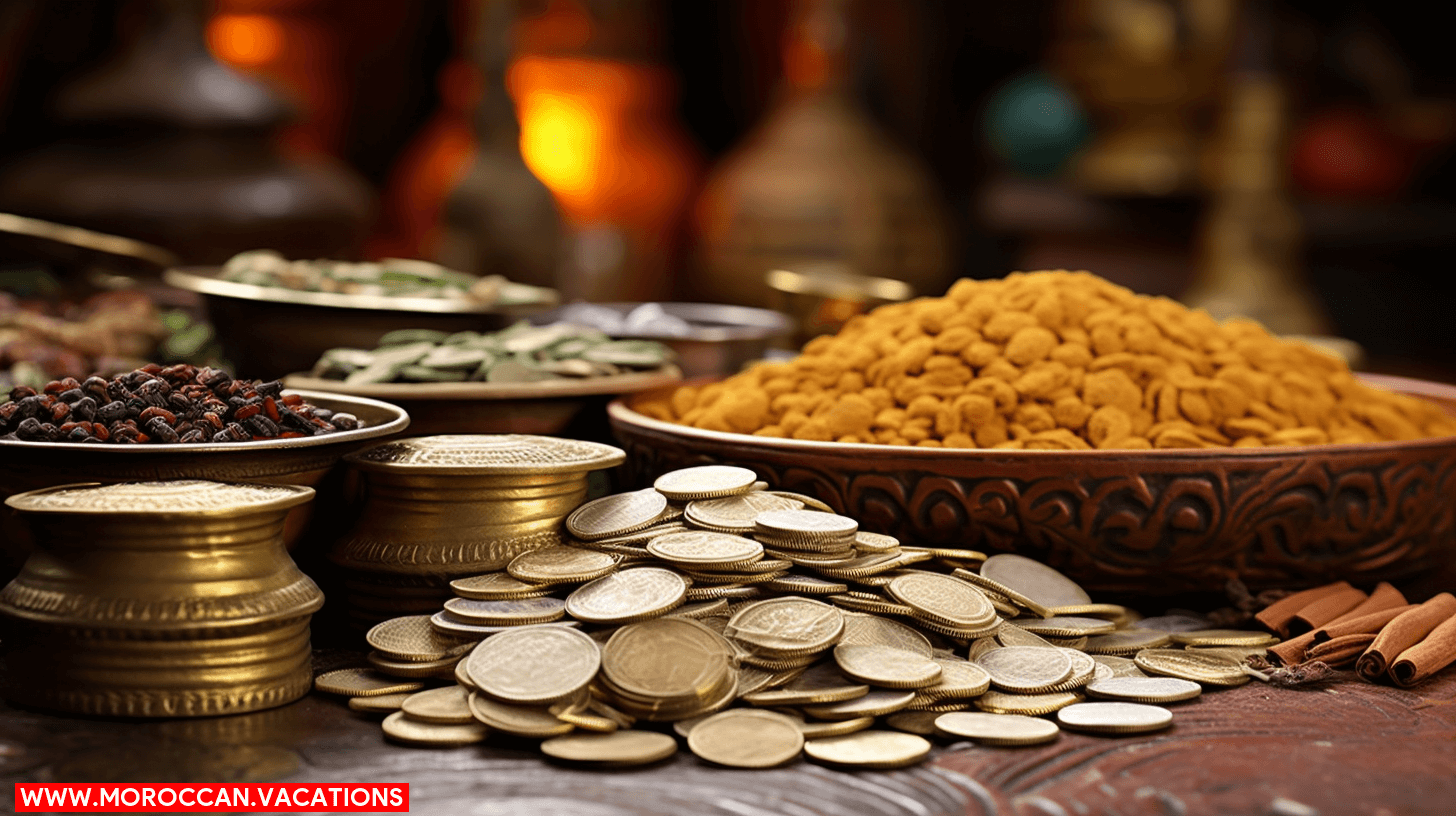

Just as a bird isn’t bound by borders, you’re not tethered to a single currency. When you soar into Morocco, you’ll trade your familiar banknotes for the country’s official currency, the Moroccan Dirham (MAD). Currency in Morocco. This is your key to unlocking the vibrant markets, the savory cuisine, and the endless adventures that await in this North African gem. You’ll find the Dirham comes in both coins and banknotes, offering you the flexibility to navigate purchases big and small. As you immerse yourself in the local culture, understanding the value of the Dirham isn’t just practical—it’s a gateway to the freedom of exploring Morocco on your own terms, unshackled by the constraints of the unfamiliar. So, let’s dive into the nuances of the Dirham and set you up for a journey of boundless discovery.
You’ll find the Moroccan Dirham, denoted as MAD, serves as the nation’s official currency, with both coins and banknotes circulating in varied denominations. Understanding the exchange rates and the process for converting foreign currency is crucial for any financial transactions you may undertake in Morocco. Notably, the Dirham is considered a closed currency, which implies specific legal restrictions on its use and exchange outside the country’s borders.
Moroccan Dirham: The Official Currency
The Moroccan Dirham, denoted as MAD or Dhs, is your key to financial transactions within Morocco. It’s the tangible symbol of economic autonomy, ensuring currency stability through meticulous monetary policy. The Dirham’s circulation is carefully managed, reflecting Morocco’s economic vitality and your purchasing power. To protect this value, robust anti-counterfeiting measures are in place, ensuring your transactions are secure. Meanwhile, whispers of a Digital Dirham suggest a future where your financial freedom meshes with the digital revolution.
- Dirham circulation: Reflects a thriving economy securing your financial independence.
- Currency stability: Offers peace of mind in your financial endeavors.
- Anti-counterfeiting measures: Safeguard your hard-earned money.
- Digital Dirham: Promises a seamless, modern financial experience.
- Monetary policy: Ensures long-term economic freedom and prosperity.
Denominations of Banknotes and Coins
Exploring the Moroccan Dirham further, you’ll find a variety of banknotes and coins, each with its own unique design and value. Banknote security features, such as watermarks and holograms, are incorporated to combat counterfeiting. Recent transitions to polymer notes have enhanced currency durability, ensuring your Dirham withstands the test of time and use.
Morocco’s minting process for coins is meticulous, aiming to produce not just legal tender but also coin collectibles that celebrate the nation’s heritage. Here’s a quick breakdown:
| Denomination | Type |
| 20, 50, 100, 200 | Banknotes |
| 1/2, 1, 2, 5, 10 | Coins |
| Polymer notes | Enhanced Durability |
| Coin Collectibles | Minting Excellence |
As you handle Moroccan currency, you’re engaging with a product of sophisticated design and thoughtful craftsmanship.
Exchange Rates and Foreign Currency
As you venture beyond the aesthetics of Moroccan currency, it’s essential to grasp how the Dirham stacks up against foreign currencies in the exchange market. Currency stability is pivotal, and the Moroccan Dirham has historically maintained a relatively stable position, although inflation impact can prompt fluctuations. Exchange controls are implemented by Morocco to regulate Dirham convertibility and protect economic equilibrium.
- Currency Stability: A cornerstone for your financial confidence and autonomy.
- Inflation Impact: Affects your purchasing power, demanding your astute attention.
- Exchange Controls: Ensure you’re informed to navigate financial boundaries with ease.
- Remittance Trends: Reflects the ebb and flow of Morocco’s economic connectivity.
- Black Market: Beware of risks, and uphold your financial integrity.
Stay analytical and precise as you engage with Moroccan currency, cherishing your financial freedom.
Local Currency Exchange in Morocco
Navigating local currency exchange in Morocco, you’ll find the Dirham’s value subject to daily market dynamics, which can influence how far your foreign currency stretches. To ensure Dirham liquidity, it’s crucial to transact at reputable exchanges, where currency authenticity is guaranteed. Beware of counterfeit bills that could disrupt your financial freedom.
Your budget tips should include exchanging enough money to cover expenses in places where cards aren’t widely accepted, especially among street vendors. Cash is king, and having Dirhams on hand empowers you to partake in Morocco’s vibrant bargaining culture. This skill is particularly valuable in markets and with taxis, where negotiation is expected. Smart currency management enhances your purchasing power and ensures an unburdened exploration of Morocco’s rich tapestry of experiences.
Is the Dirham a Closed Currency?
Understanding the intricacies of the Moroccan Dirham is essential, as it’s a closed currency, meaning you can’t trade it outside the country’s borders. Dirham convertibility is strictly regulated by the Moroccan government to maintain economic stability and control under a stringent monetary policy. This restriction often feels like a shackle on your financial freedom, particularly when it comes to travel restrictions and managing finances abroad.
- Embrace the uniqueness: Morocco’s distinct financial landscape.
- Plan meticulously: Navigate travel with foresight to avoid monetary mishaps.
- Avoid temptations: Circumvent the black market’s false allure.
- Acknowledge limits: Understand and respect import/export constraints.
- Policy awareness: Stay informed on Morocco’s monetary regulations.
You’ll encounter these challenges head-on, armed with knowledge that empowers you beyond the limitations imposed by closed currency systems.
Exchanging Money in Morocco
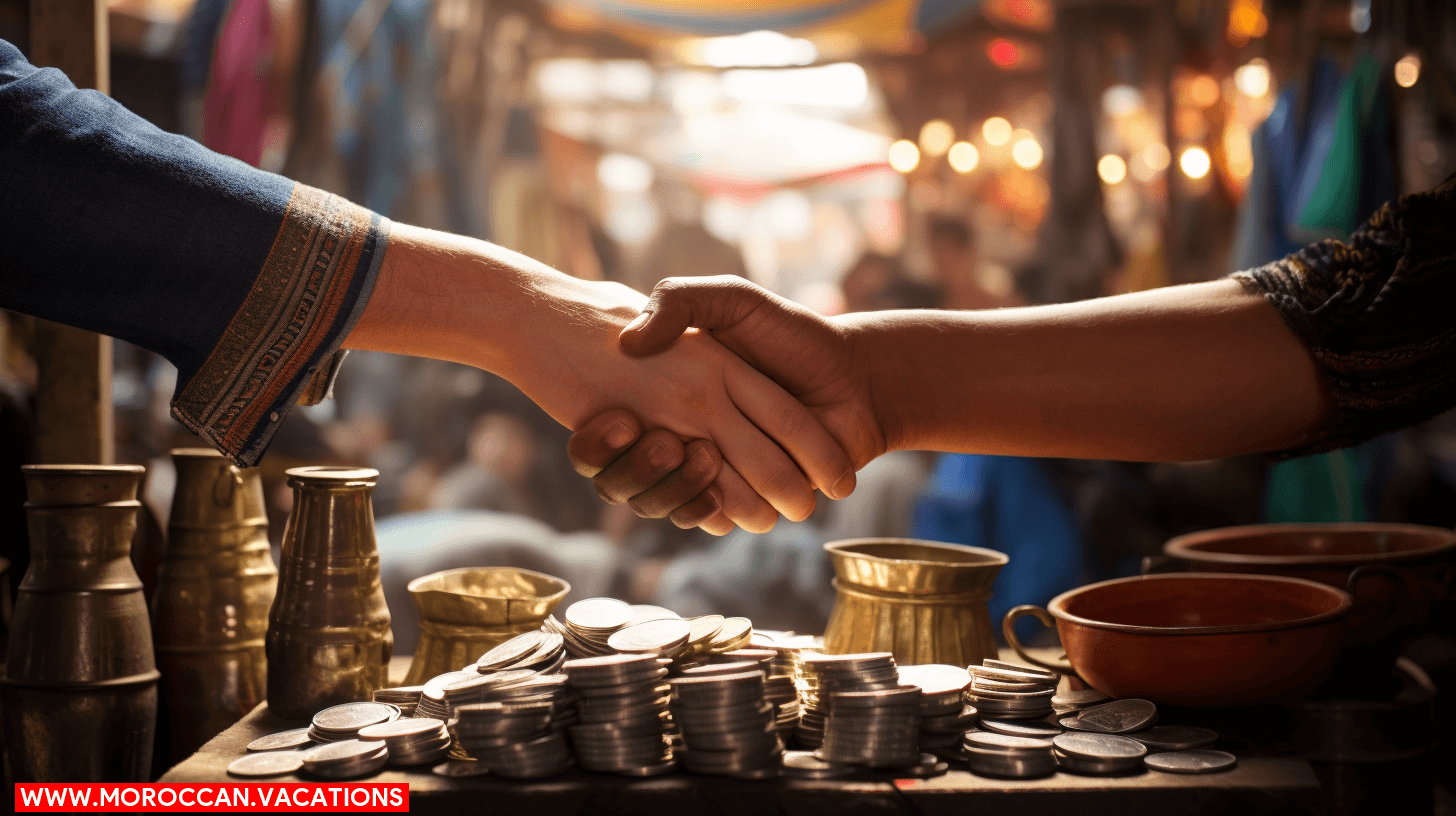

When you’re in Morocco, you’ll need to convert your currency into Moroccan dirhams for ease of transactions. While US dollars and euros are occasionally accepted, especially in tourist areas, it’s more practical to have local currency on hand. You’ll find currency exchange services at airports, major hotels, and designated exchange bureaus, but it’s wise to compare rates and consider online options for potentially better deals.
Currency Exchange Overview
Exchanging your home currency for Moroccan dirhams is a straightforward process at banks, hotels, and authorized bureaus throughout Morocco. Understanding the currency liquidity and market dynamics is crucial for a smooth experience. Exchange controls are relatively liberal, allowing you to adapt to the local economy with ease. Be aware of currency speculation and always consider the historical exchange rates to ensure fair transactions.
- Freedom to Explore: Navigate the markets with the local currency in hand.
- Historical Context: Reflect on the dirham’s past to inform your present exchanges.
- Market Insight: Stay informed about real-time fluctuations in currency value.
- Control Over Finances: Exchange your money on your own terms.
- Speculative Awareness: Guard against unfavorable speculative shifts.
Using US Dollars in Morocco
Bringing US dollars to Morocco, you’ll find them accepted in some tourist areas, but exchanging them for dirhams is essential for most transactions. Although dollar acceptance provides you with a sense of familiarity, spending USD directly can be impractical and often incurs poor exchange rates.
For a seamless experience, prioritize currency conversion upon arrival. Exchange bureaus and banks offer this service with varying rates and commissions. To aid your understanding, here’s a table illustrating key points:
| Location | American Currency Handling | USD Tips |
| Tourist Spots | Limited acceptance | Carry small bills |
| Local Markets | Dirhams required | Exchange first |
| Accommodations | Some may accept USD | Confirm in advance |
Ensure you’re informed about the latest rates and fees for an efficient and cost-effective exchange.
Using Euros in Morocco
Many travelers find that using euros in Morocco is a convenient alternative, as they’re widely accepted in major cities and tourist destinations. When you’re looking to experience the rich culture and vibrant markets of Morocco, understanding the Euro influence on tourist transactions can enhance your journey.
- Euro acceptance in upscale hotels and shops grants you the freedom to spend without the hassle of frequent conversions.
- Exchanging money at official bureaux de change ensures a precise Euro conversion, safeguarding your purchasing power.
- Spending euros directly can be a strategic choice, circumventing the need for multiple currency exchanges.
- Vigilance in transaction rates prevents unforeseen losses, preserving your financial autonomy.
- Knowing the Euro influence on local pricing can sharpen your negotiation skills in bustling souks.
Navigate Morocco’s monetary landscape with confidence, leveraging the euro to unlock a seamless travel experience.
Where to Exchange Currency in Morocco
Travelers can conveniently exchange their currency at Moroccan banks, authorized money changers, and some hotels. However, it’s essential to remain vigilant about currency scams. Always request a receipt and count your currency before leaving the exchange desk. For ATM safety, use machines located inside or in front of banks to reduce the risk of tampering or card skimming.
Traveler’s cheques are not commonly accepted, so it’s prudent to rely on cash or credit cards. Credit card acceptance is growing, especially in urban areas and tourist hotspots, but don’t assume it’s available everywhere. Understand the payment preferences in each establishment to avoid any inconvenience. In Morocco, having a mix of payment methods ensures you’re prepared for all transactions.
Online Currency Exchange Options
In light of the digital age, you’ll find that online platforms offer convenient options for exchanging your money before or during your stay in Morocco. Embrace the freedom of managing finances remotely through:
- Digital wallets: Simplify transactions with instant access to funds.
- Forex apps: Enable real-time currency conversion with precision.
- Cryptocurrency usage: Explore alternative payment methods with a modern twist.
- Online remittances: Send and receive money swiftly across borders.
- Payment gateways: Connect with local vendors through seamless interfaces.
These tools allow you to analyze exchange rates critically, make informed decisions, and execute transactions with ease. The digital landscape in Morocco is evolving, providing you with an array of options to handle your currency needs efficiently and securely.
Sending Money to and from Morocco
When you need to transfer funds to or from Morocco, you’ll find a range of services from bank wire transfers to online money transfer platforms that offer convenient and efficient solutions. International banking options facilitate seamless transactions, but it’s critical to stay abreast of currency regulation changes that may affect the flow of dirhams. Money transfer services have evolved, responding to remittance trends that show a growing preference for digital payment platforms due to their ease of use and speed. These platforms often provide competitive exchange rates and lower fees compared to traditional banks. Analyzing the market will ensure you use the most cost-effective and reliable service for your financial needs, maintaining your freedom in global commerce.
Traveling with Moroccan Currency
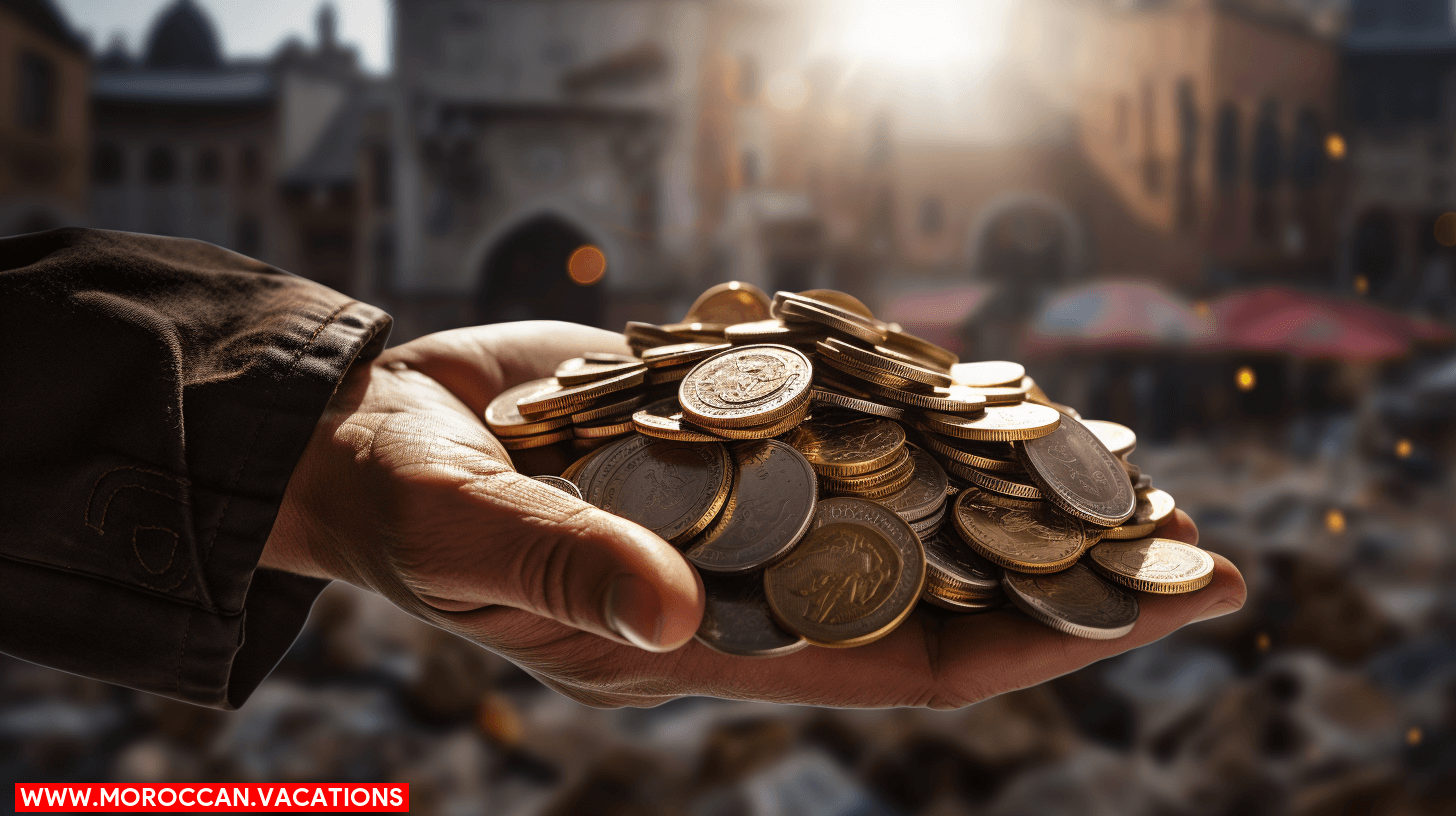

As you travel through Morocco, it’s crucial to understand how to manage your funds efficiently. Familiarize yourself with the nuances of using credit and debit cards, and know where to find ATMs that dispense local currency. Be aware of currency conversion fees, especially when exchanging money at airports and tourist-heavy areas where rates may be less favorable.
Managing Currency While Traveling in Morocco
Understanding currency management is crucial as you navigate Morocco’s vibrant markets and bustling cities. To maintain currency safety and prevent tourist scams, it’s essential to be vigilant. Budget planning ensures you enjoy the freedom to explore without financial worry. Be aware of cash accessibility; not all places accept cards, and knowing local payment preferences can save you from awkward situations.
Consider these key points for a smooth experience:
- Always keep currency secure and concealed.
- Diversify your money sources; don’t rely solely on cash.
- Familiarize yourself with common scams to stay one step ahead.
- Plan your budget to maximize your travel freedom.
- Understand where and when cards are accepted to avoid being cash-strapped.
Stay informed and precise in your currency management for an unrestricted Moroccan adventure.
Using Credit and Debit Cards in Morocco
Many establishments in Morocco accept credit and debit cards, but you’ll find that some smaller vendors and rural areas still prefer cash transactions. Navigating through the maze of card acceptance can be less burdensome if you’re equipped with knowledge about ATM fees and payment security. Digital wallets are gaining traction, though their usage isn’t ubiquitous. For added convenience, seek out venues that support contactless payments, streamlining your purchasing experience.
| Aspect | Consideration |
| Card Acceptance | Widely in cities, less in rural areas |
| ATM Fees | Can be high, compare bank rates |
| Payment Security | Use secure ATMs, shield PIN entry |
| Digital Wallets | Emerging, not widespread |
| Contactless Payments | Increasingly available, especially in cities |
In your pursuit of freedom while traveling, an analytical approach to these facets ensures a smooth financial experience in Morocco.
ATMs and Moroccan Currency
When you’re traveling in Morocco, you’ll need to get a handle on using ATMs to withdraw the local currency, the Moroccan dirham (MAD). Navigating ATM locations can be straightforward; you’ll find them in airports, major cities, and even small towns. However, understanding withdrawal limits is crucial—they vary by bank and can affect your budgeting.
- ATM Locations: Abundant in urban areas, less so in remote regions.
- Withdrawal Limits: Check with your bank to avoid surprises.
- Card Compatibility: Ensure your card is accepted to prevent being cash-strapped.
- Transaction Security: Use ATMs in well-lit, secure locations.
- Cashless Options: Consider mobile payments where available for convenience.
Analyzing these factors ensures transaction security and gives you the freedom to enjoy your travels without the worry of being without funds.
Understanding Currency Conversion Fees
As you manage your finances while traveling in Morocco, it’s crucial to be aware of the currency conversion fees that can accompany transactions. Currency fluctuations often impact the value of your money, necessitating savvy Forex strategies to minimize losses. Utilize transfer services with transparent fee structures to ensure you’re not paying more than necessary. Digital wallets may offer competitive rates and lower fees compared to traditional banks, granting you more financial freedom as you navigate Moroccan markets.
Enhancing your financial literacy before your trip can save you from unwelcome surprises. By understanding these nuances, you’ll wield your spending power more effectively, sidestepping excessive costs while relishing the rich experiences Morocco has to offer.
Exchanging Currency at Airports and Tourist Areas
Upon arriving in Morocco, you’ll find currency exchange services readily available at airports and popular tourist destinations. However, be mindful of airport fees which can diminish your funds. You’re seeking the liberty to explore without financial worry, and being informed is key to achieving that freedom.
- Airport fees: Often higher, reducing the value you receive.
- Street vendors: May not accept traveler’s checks and prefer cash.
- Currency scams: Vigilance is necessary to avoid deceitful exchange rates.
- Payment preferences: Local businesses might favor cash transactions.
- Traveler’s checks: Less convenient and often incur additional exchange costs.
Engage in currency exchange with a strategic approach to ensure maximum financial autonomy. Avoid the pitfalls of currency scams by researching current exchange rates. Embracing local payment preferences will enhance your market interactions and safeguard your purchasing power.
Insights into Moroccan Currency Economy
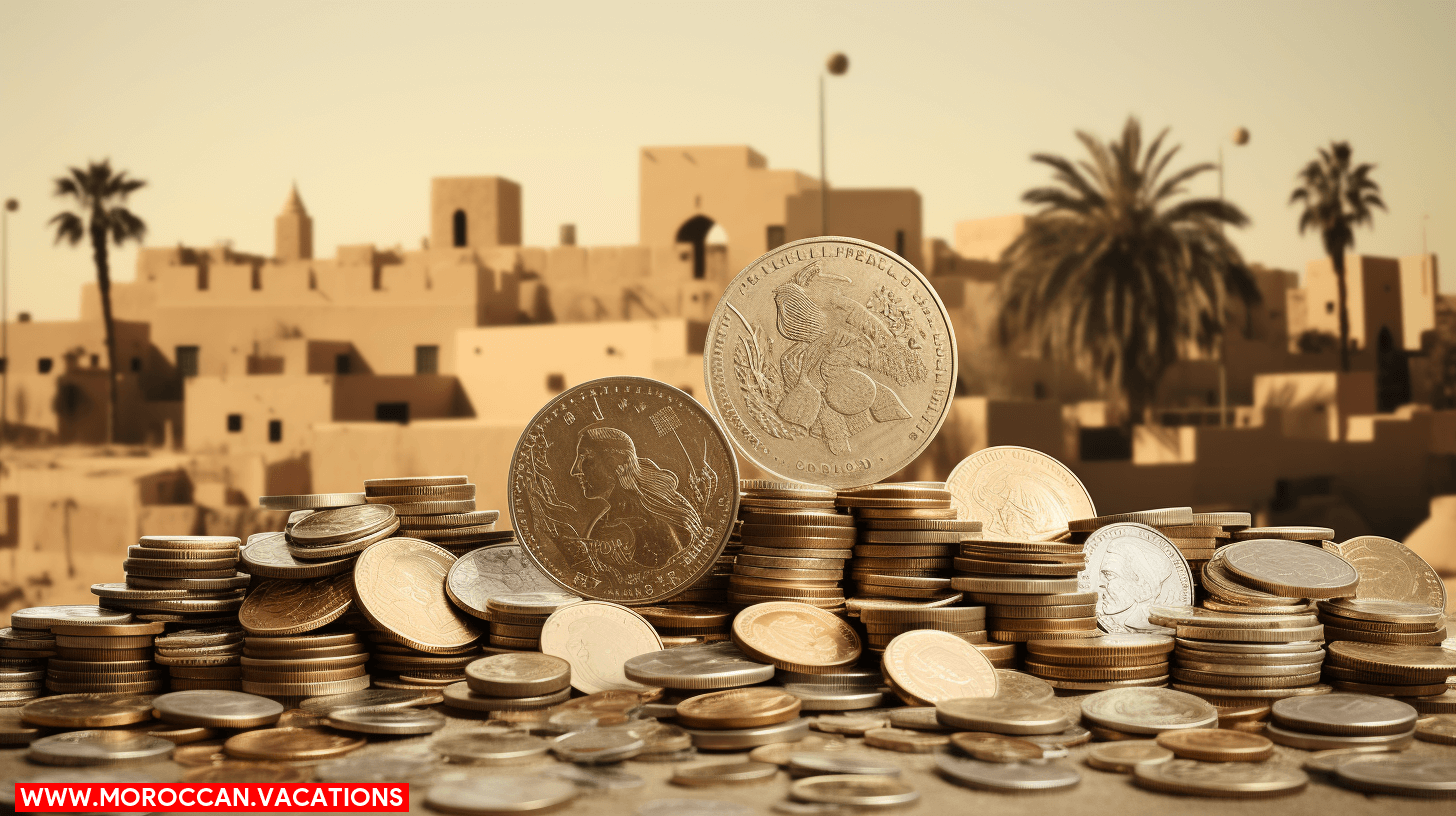

You’ll find that the Moroccan dirham is not the sole player in the nation’s economy; the Euro and US Dollar hold significant sway in local transactions, especially in tourist areas. Internationally, Morocco’s currency policies and regulations shape the dirham’s standing and ensure its stability against the backdrop of global currency markets. Keep an eye on recent shifts in the Moroccan currency market, as they reflect the country’s economic responses to worldwide financial trends.
The Role of Euro and US Dollar in Morocco
In Morocco, your transactions in tourist areas and certain businesses may often be facilitated by using euros or US dollars, reflecting their significant role in the local economy. Euro adoption and dollar influence enhance currency stability, while international remittances and trade balance impacts underscore the intricate relationship between Moroccan dirhams and these foreign currencies.
- Euro adoption: Integrates Morocco more closely with European markets.
- Dollar influence: Asserts the US currency as a benchmark for trade and valuation.
- Currency stability: Offers a safeguard against local inflationary pressures.
- International remittances: Bolster the economy through foreign currency influx.
- Trade balance impacts: Affect the valuation of the dirham, steering economic policy.
Embrace the financial freedom that understanding these currencies brings to your experience in Morocco.
Moroccan Currency in the International Market
As you explore Morocco’s economic landscape, it’s important to understand how the Moroccan dirham fares on the international market. Dirham liquidity, a key factor for stability, is relatively controlled due to Morocco’s foreign exchange regulations, limiting currency speculation. However, for those interested in the dirham’s investment potential, it’s crucial to keep an eye on market trends and seek out reputable trading platforms that offer access to this currency.
| Aspect | Detail | Relevance to Dirham |
| Dirham Liquidity | Managed by Moroccan authorities | Limits speculative trading |
| Currency Speculation | Tightly regulated | Stabilizes investment potential |
| Investment Potential | Influenced by macroeconomic factors | Can attract foreign investors |
| Market Trends | Reflects regional economic health | Helps predict dirham performance |
| Trading Platforms | Few offer dirham trading | Access is key for international investors |
Moroccan Currency Policies and Regulations
Understanding the currency policies and regulations that govern the Moroccan dirham is essential as you delve into the nation’s monetary system. Here’s what you need to know:
- Dirham Convertibility: The dirham’s convertibility reflects the nation’s economic openness, enabling you to engage in cross-border transactions with relative ease.
- Monetary Policy: The central bank’s strategies aim to maintain price stability, ensuring your purchasing power isn’t eroded by inflation trends.
- Inflation Trends: Observing these will help predict potential fluctuations, safeguarding your financial plans.
- Fiscal Stability: Morocco’s fiscal policies are geared toward sustainability, protecting your investments from erratic economic shifts.
- Central Bank Strategies: These are designed to foster growth, so you can pursue opportunities with confidence in a stable monetary environment.
Analyzing these facets offers a comprehensive understanding of the framework ensuring the dirham’s reliability and your financial liberty.
Influence of Global Currency Markets on Moroccan Dirham
Your understanding of the Moroccan dirham’s value isn’t complete without considering its susceptibility to the ebb and flow of global currency markets. Global inflation impact can significantly affect the dirham, as rising prices worldwide may devalue it in relation to stronger currencies. The dirham’s trading partners play a crucial role; trade imbalances with these countries can lead to fluctuations in the dirham’s value. Currency market trends, dictated by investor sentiment and geopolitical events, often dictate the dirham’s performance against major currencies. Meanwhile, Morocco’s monetary policy influence, enacted by its central bank, aims to stabilize the dirham through interest rates and other financial tools. Lastly, the foreign reserves role is pivotal in cushioning the dirham against sudden shocks, ensuring a degree of economic sovereignty.
Recent Developments in Moroccan Currency Market
You’ll find that recent policy changes and fluctuating trade dynamics have marked significant shifts in the Moroccan currency market. As you navigate through this evolving financial landscape, consider the following key developments:
- Moroccan inflation trends have shown resilience amidst regional pressures, reflecting the nation’s economic adaptability.
- Dirham digitalization efforts are paving the way for enhanced transactional freedom and efficiency.
- The Cryptocurrency impact is prompting a reevaluation of financial sovereignty and user autonomy.
- Remittance flow changes are reshaping the economic contribution of the Moroccan diaspora.
- Central bank policies are becoming increasingly strategic, aimed at safeguarding monetary stability and fostering growth.
These elements are crucial for understanding the current state and trajectory of Morocco’s currency economy.
History and Culture of Moroccan Currency
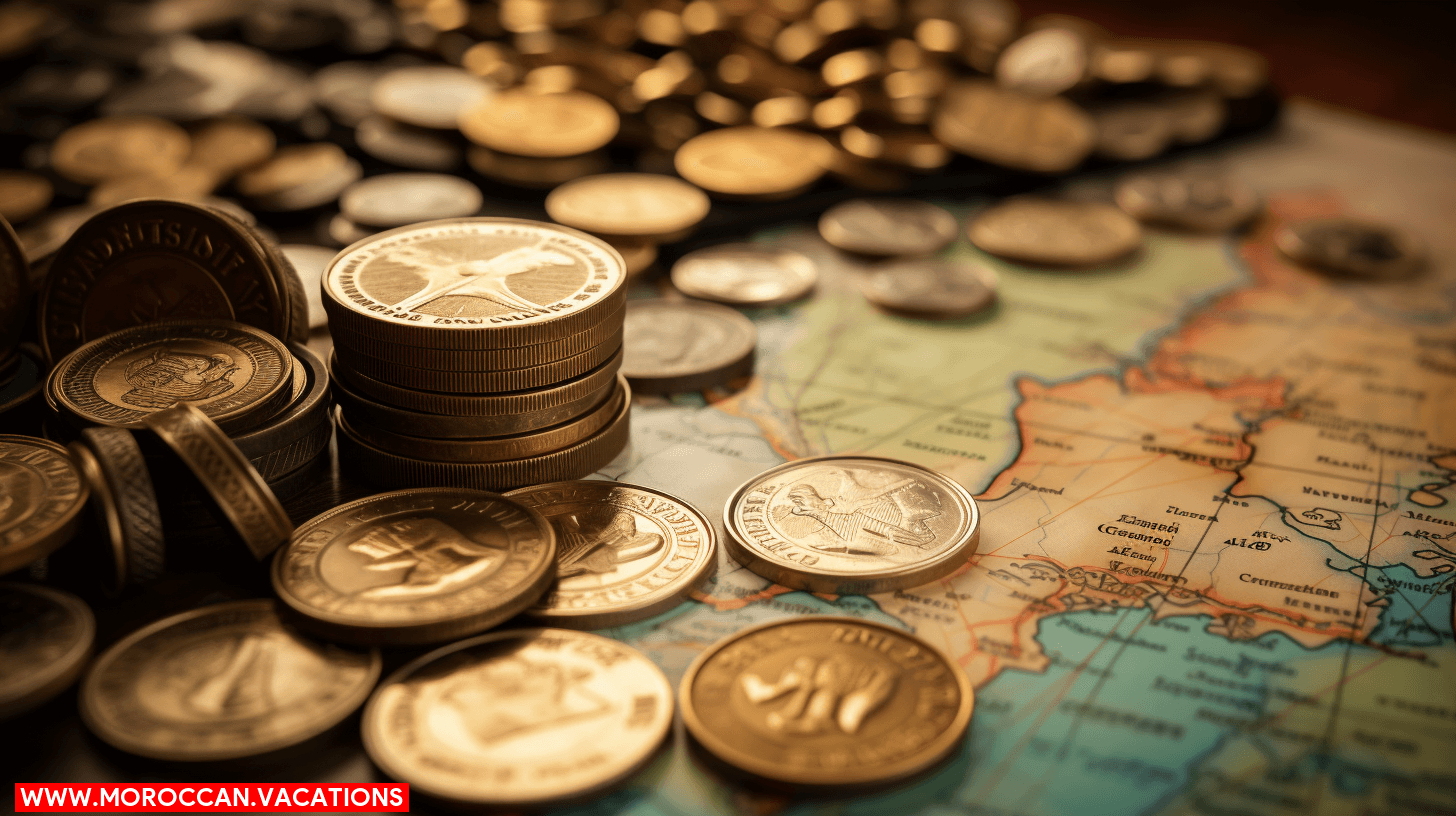

You must consider the evolution of the Moroccan Dirham to grasp its current cultural and economic significance. The symbols permeating Moroccan currency offer insights into the nation’s identity, reflecting both historical narratives and artistic heritage. Analyzing the Dirham’s journey through time reveals the intricate relationship between a country’s currency and its cultural ethos.
Evolution of Moroccan Dirham
The Moroccan dirham, which you’ll recognize by its symbol MAD, has a rich history that reflects the country’s cultural and economic transformations. Tracing the dirham’s origin to ancient times, you’ll find that currency reforms have been pivotal in shaping its current form. Numismatic collectors value the dirham for its intricate designs, which weave in elements of Morocco’s storied past. Rigorous counterfeit prevention measures ensure the currency’s integrity, contributing to the nation’s monetary stability.
- Dirham Origin: A tangible link to Morocco’s ancient commerce heritage.
- Currency Reforms: Pivotal steps towards a robust financial system.
- Numismatic Collectors: Guardians of the dirham’s historical narrative.
- Counterfeit Prevention: A relentless pursuit for authenticity.
- Monetary Stability: The cornerstone of economic freedom and prosperity.
Significance of Moroccan Currency Symbols
Diving into the symbols adorning Moroccan currency, you’ll uncover stories deeply embedded within the nation’s history and culture. Dirham symbolism is not merely ornamental; it’s a narrative canvas, reflecting the numismatic heritage of Morocco. The currency motifs employed on banknotes and coins serve as a testament to the country’s rich history, diverse culture, and national identity.
Monetary iconography is selected with precision to encapsulate Moroccan ethos. Banknote aesthetics, for instance, are imbued with images that range from architectural marvels to prominent historical figures, each element chosen to resonate with the liberty you cherish. By understanding these symbols, you gain insight into Morocco’s societal values and the pride of a people expressed through the very currency they circulate.
The Moroccan Dirham in Historical Context
Understanding Moroccan dirhams takes you back to a time when currency was more than just a medium of exchange; it was a marker of cultural identity and national pride. The dirham’s origins can be traced through numismatic studies, revealing a rich tapestry of historical exchange that underscores Morocco’s place in the world.
- Dirham origins reflect centuries-old civilizations that valued trade and innovation.
- Coinage evolution showcases Morocco’s adaptability and resilience through time.
- Monetary reforms highlight the country’s pursuit of economic sovereignty and modernization.
- Historical exchange rates tell stories of Morocco’s interaction with global economies.
- Numismatic studies offer a window into the past, preserving the legacy of Moroccan culture.
Your understanding of the Moroccan dirham isn’t just about numbers; it’s about appreciating a currency steeped in history and symbolic of a nation’s quest for freedom and progress.
Currency Art and Design in Morocco
As you explore Morocco’s dirhams, you’ll notice that each banknote and coin is a canvas, reflecting the nation’s history, culture, and artistic heritage through its intricate designs. The numismatic heritage of Morocco is encapsulated in the currency aesthetics, with banknote colors and artisanal motifs chosen to symbolize the country’s rich tapestry of traditions and achievements. The meticulous artistry of the dirhams captures collector’s interest, serving not only as a medium of exchange but also as a testament to Morocco’s identity. Each piece is crafted to convey a story, embedding elements of Morocco’s past and present into the daily transactions of its people. The dirham’s design is a deliberate celebration of freedom, cultural expression, and national pride.
Cultural Implications of Moroccan Currency
In your exploration of Moroccan currency, you’ll discover that the dirham is not just a means of transaction but also a reflection of the nation’s storied history and cultural identity. The dirham’s role in the Moroccan economy is pivotal, shaping the monetary heritage that is deeply ingrained in the fabric of society. Currency aesthetics reveal stories of Morocco’s past, from ancient civilizations to modern-day achievements.
- Embracing Monetary heritage with pride
- Feeling the weight of history in Dirham circulation
- Cherishing Currency aesthetics as a national artwork
- Practicing Money rituals that signify respect and tradition
- Fueling the Moroccan economy with every transaction
Analyzing this, you grasp the significance of the dirham beyond mere spending power—it’s a symbol of freedom and a testament to Morocco’s rich cultural tapestry.
Introducing Ayoub Karbachi, a brilliant wordsmith and curator of the Moroccan Vacations website. Prepare to immerse yourself in mesmerizing narratives and extraordinary moments, as he unveils the allure of Morocco's captivating destinations like never before.
Related Articles
What Is the Capital of Morocco? Unveiling the Geographical Marvel of North Africa.
Where Is the Capital of Morocco Located? You might be thinking, "Why should I care about the capital of Morocco?" Well, let's uncover the fascinating city of Rabat, the capital of Morocco, and its unique charm in North Africa. Get ready to explore the geographical...
What Language Do They Speak in Morocco?
“Discover the rich cultural tapestry of Morocco as we explore the question: ‘What language do they speak in Morocco?’ Uncover the linguistic diversity that defines this North African gem. From Arabic and Amazigh to French and Spanish influences, our guide navigates the linguistic landscape of Morocco. Gain insights into the importance of language in Moroccan society and travel prepared for a truly immersive experience. Unveil the answer to ‘What language do they speak in Morocco?’ and embark on a linguistic journey through this captivating destination.
What Animals Live in the Sahara Desert
Types of Animals Found in the Sahara Desert Photo by: @https://owlcation.com/stem/sahara-desert-animals Imagine yourself tracking the majestic dromedary camel across the vast, sandy dunes of the Sahara Desert. As you embrace the spirit of adventure, you're not alone...

